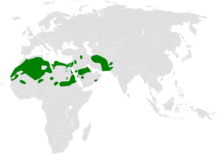Sand lark
| Sand lark | ||||||||||||
|---|---|---|---|---|---|---|---|---|---|---|---|---|

Sand lark |
||||||||||||
| Systematics | ||||||||||||
|
||||||||||||
| Scientific name | ||||||||||||
| Ammomanes cinctura | ||||||||||||
| ( Gould , 1839) |
The sand lark ( Ammomanes cinctura ) is a kind from the family of larks . Their distribution area extends from North Africa to Asia. There are three subspecies.
The population situation of the sand lark is classified by the IUCN as harmless ( least concern ).
features
The sand lark reaches a body length of 13 to 16 centimeters. The beak length measured from the skull is 1.16 to 1.48 centimeters. They weigh between 21 and 23 grams. There is no noticeable gender dimorphism .
The sand lark is a small reddish and gray-colored lark, the plumage of which hardly shows any dotted lines. The top of the body is yellowish to pinkish-cinnamon brown. The forehead and crown are a little grayer than the rest of the upper plumage and have a few darker points and lines. The chin and throat are whitish, the chest is light yellow-brown with barely discernible dotted lines. The belly is whitish to very light yellow-brown. The tail plumage is pale yellow-brown to reddish brown. Characteristic of the sand lark is the black, sharply set off end band on the tail feathers, which is widest on the middle pair of tail feathers. All control springs are also lined with a very narrow yellow-brown.
Possible confusion
The sand lark is very similar to the occurring in the same habitat and habitat Desert Lark on. This is a little bigger. The sand lark differs from the stone lark, among other things, in the black end band on the tail plumage. The sand lark differs from the single lark by the lack of dashed lines on the upper side of the body.
Distribution area, subspecies and habitat
The distribution area of the sand lark extends from the Cape Verde Islands via Senegal, Mauritania, Western Sahara, Morocco, Mali, Algeria, the south of Tunisia, Libya, Egypt, Sudan, the Arabian Peninsula, Iran to Afghanistan and Pakistan. It is a resident bird that is partially nomadic. She is occasionally seen as a stray visitor in Kuwait , Syria , Italy and Malta .
The individual subspecies can be found in the following regions:
- A. c. cinctura - ( Gould , 1839) : Occurrence on the Cape Verde Islands
- A. c. arenicolor - ( Sundevall , 1850) : The subspecies was originally described as a separate species of the genus Alauda . It occurs in the deserts of North Africa to the Sinai Peninsula and the west of the Arabian Peninsula .
- A. c. zarudnyi - Hartert , 1902 : Occurrence in the east of Iran, in the south of Afghanistan and Pakistan. It is the darkest subspecies with the most clearly developed terminal band on the tail feathers.
The habitat of the sand lark are stony and sandy deserts as well as bush steppes and barren wasteland. The sand lark does not occur on agricultural land.
Way of life
The sand lark eats seeds, green plant material and insects. She is a fast runner on the ground who keeps pausing. It almost never rises.
The male rises from the ground in singing flight and begins to sing at a height of three to six meters. Singing, the male climbs up and down in butterfly-like up and down circular flights up to 30 meters before returning to the ground.
The breeding season on the Cape Verde Islands falls between September and April. In Pakistan it breeds in March and April. Like all larks, the sand lark is a ground breeder. Both parent birds are involved in nest building and the rearing of the young birds.
literature
- Rudolf Pätzold: The larks of the world . Westarp Sciences, Magdeburg 1994, ISBN 3-89432-422-8 .
- Rudolf Pätzold: Compendium of Larks. All the larks on earth. Jan-Schimkat-Medienpublikation, Dresden 2003, ISBN 3-00-011219-7 .
